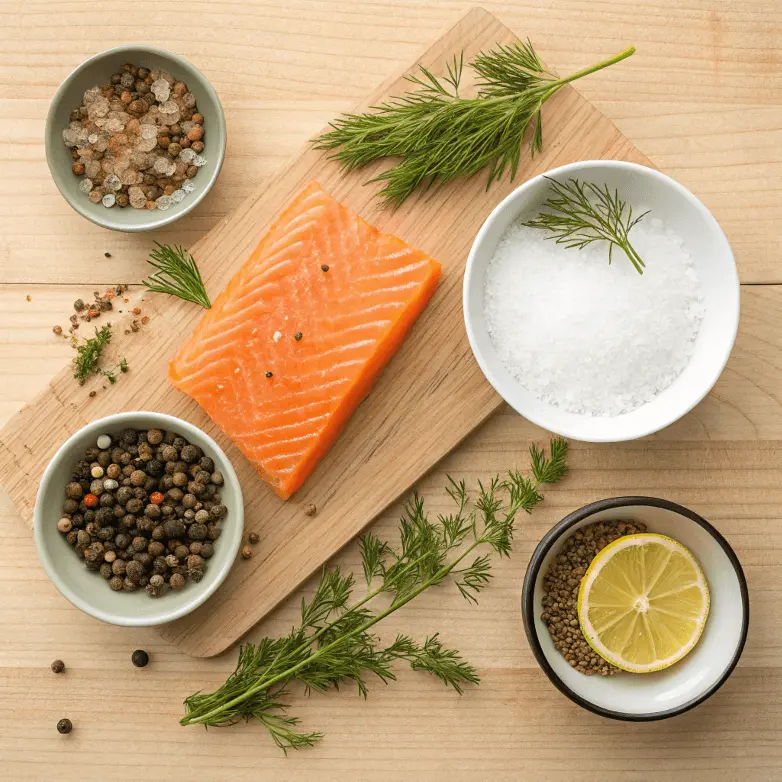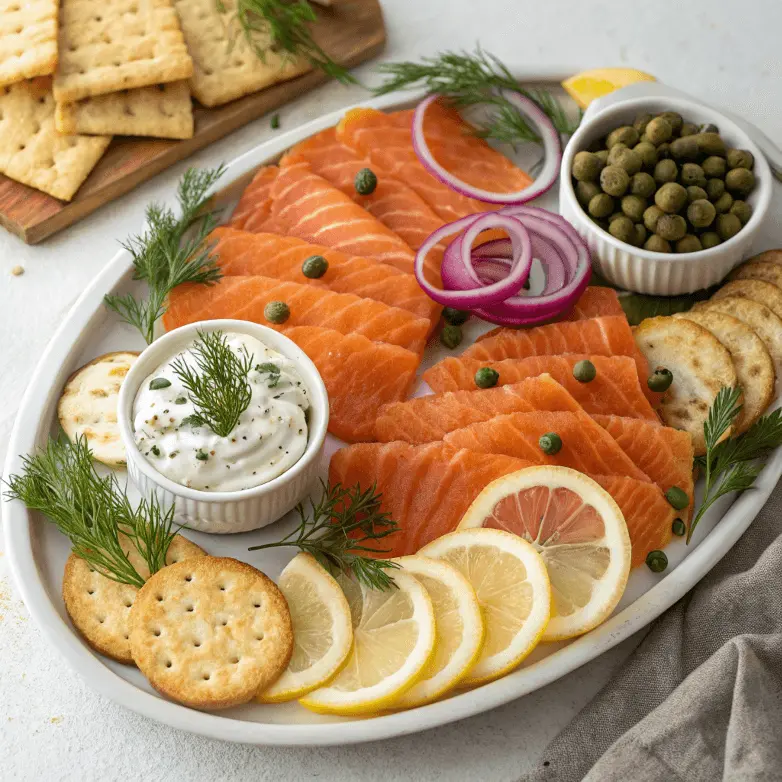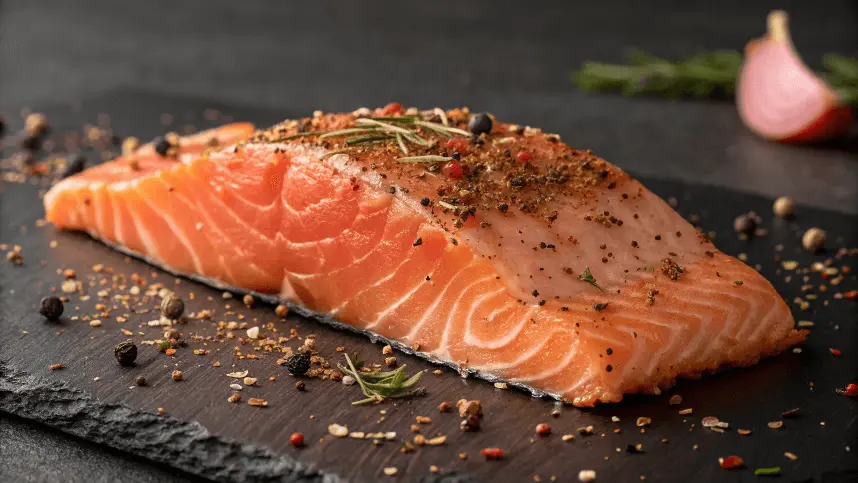Smoked salmon brine recipe—just hearing those words might bring back memories of cozy mornings, buttery bagels piled high with silky, smoky slices of salmon, and the satisfying crunch of fresh veggies on the side. But have you ever wondered what makes smoked salmon taste so incredible? The secret starts long before the fish hits the smoker: it’s all in the brine.
In this guide, we’ll walk you through everything you need to master the art of brining salmon for smoking, from the ideal salt-to-sugar ratios to expert smoking tips. Whether you’re a beginner or a backyard smoking enthusiast, get ready to elevate your homemade smoked salmon to the next level.
Table of Contents
What Is a Smoked Salmon Brine and Why Use It?
If you’re making a smoked salmon brine recipe, it’s important to know why brining is such a key step. Brining is the process of soaking salmon in a saltwater solution before smoking. This simple step does more than just season the fish—it plays a crucial role in improving texture, flavor, and safety.
Here’s why brining matters:
- Moisture retention: The salt in the brine draws out moisture but then helps the salmon reabsorb it, keeping the fish juicy during smoking.
- Enhanced flavor: A brine infuses salmon with balanced saltiness and subtle flavors from herbs and spices.
- Food safety: Brining helps kill harmful bacteria and firms up the flesh, making it safer and easier to smoke.
Wet Brine vs. Dry Brine: What’s the Difference?

There are two main types of brine used in smoked salmon recipes: wet brine and dry brine.
| Brine Type | Description | Best For |
|---|---|---|
| Wet Brine | A liquid solution of water, salt, sugar, and spices. | Adding moisture and subtle flavor |
| Dry Brine | A dry mixture of salt, sugar, and spices rubbed directly onto the fish. | Intensifying flavor and drawing out moisture |
Wet brines are ideal for beginners because they are easy to prepare and provide consistent results. Dry brines are great if you want a stronger, saltier crust on the outside of your smoked salmon.
Pro Tip: No matter which method you choose, always brine your salmon in the fridge to keep it fresh and safe.
And if you’re looking for even more ways to enjoy salmon, don’t miss these delicious ideas for salmon bites—perfect as appetizers alongside your smoked creations.
Essential Ingredients for the Best Smoked Salmon Brine Recipe
Creating a flavorful smoked salmon brine recipe starts with understanding how each ingredient contributes to the end result. Brining is not just about salt—every element plays a role in seasoning, tenderizing, and preserving your salmon.

Ideal Salt-to-Sugar Ratio (Explained)
The salt-to-sugar ratio is the backbone of any good brine. Salt draws moisture out of the fish initially, but then allows the salmon to reabsorb moisture infused with flavor. Sugar balances out the saltiness and helps with browning during smoking.
For a classic wet brine:
- 1 cup kosher salt (or ¾ cup sea salt)
- 1 cup brown sugar
- 1 gallon cold water
This ratio works well for a standard brine. If you prefer a milder salt flavor, you can reduce the salt slightly, but keep the balance between salt and sugar roughly equal for best results.
Different sugars you can try:
- Brown sugar (adds depth and molasses notes)
- White sugar (milder sweetness)
- Honey or maple syrup (natural sweeteners for a richer taste)
Pro Tip: Always dissolve the salt and sugar fully in water before adding salmon to ensure even brining.
Best Herbs and Spices for Smoked Salmon
Beyond the basics, herbs and spices are what make your smoked salmon truly shine. These additions can infuse subtle aromas and flavors that enhance the overall experience.
Here’s a list of popular choices and why they work well:
| Herb/Spice | Flavor Contribution |
|---|---|
| Dill | Classic pairing; fresh, grassy taste |
| Garlic (crushed) | Adds savory depth and richness |
| Black peppercorns | Mild heat and aroma |
| Bay leaves | Earthy, slightly floral notes |
| Lemon or orange zest | Bright, citrusy balance to the rich salmon |
| Mustard seeds | Mild tang and crunch |
| Coriander seeds | Warm, citrusy flavor that complements fish beautifully |
Optional: You can toast spices like coriander or mustard seeds before adding them to the brine to release even more flavor.
Optional Add-Ins for Custom Flavor
Looking to make your smoked salmon stand out? These optional add-ins can help you craft a unique brine that impresses every time:
- Maple syrup: Natural sweetness that pairs wonderfully with smoky notes.
- Apple cider vinegar: Adds a gentle tang that balances rich flavors.
- Juniper berries: Introduce a pine-like, woodsy touch—perfect for holiday brines.
- Liquid smoke: Great if you’re brining but not using a smoker; adds a subtle smoky kick.
- Crushed red pepper flakes: A pinch gives your salmon a bit of heat.
Flavor Tip: Want a Nordic twist? Add caraway seeds and extra dill for a Scandinavian-inspired brine.
Fresh vs. Dried Ingredients: Does It Matter?
Both fresh and dried herbs work well in a brine, but keep in mind:
- Fresh herbs tend to add brighter, more delicate flavors.
- Dried herbs are more concentrated, so you can use less.
When using dried herbs, reduce the amount by about one-third compared to fresh.
Brining is your chance to infuse salmon with deep, well-rounded flavors before it ever touches the smoker. By choosing the right blend of salt, sugar, herbs and spices, you lay the foundation for smoked salmon that’s moist, flavorful, and unforgettable.
For more inspiration on salmon dishes that impress, check out the rich and flavorful marry me salmon recipe, another creative way to serve salmon lovers.
How to Make Smoked Salmon Brine Recipe (Step-by-Step)
If you’re ready to dive into your smoked salmon brine recipe, this simple guide will walk you through the entire process—from mixing the brine to prepping your salmon for smoking. Follow these steps to ensure your salmon turns out flavorful, moist, and perfectly seasoned.
1. Prepare the Brine Solution
The first step is mixing your brine. Use a large pot or container that can comfortably hold your salmon.
Basic recipe:
- 1 gallon (16 cups) of cold water
- 1 cup kosher salt
- 1 cup brown sugar
- Optional: herbs and spices (like dill, garlic, peppercorns, bay leaves)
Steps:
- Pour the cold water into your pot.
- Add salt and sugar, stirring until fully dissolved.
- Add any herbs, spices, or other flavor add-ins.
- Chill the brine in the fridge until cold before adding salmon.
Tip: Never pour hot or warm brine over raw fish—it can start to “cook” the salmon and ruin the texture.
2. Prepare the Salmon
Proper prep is key to even brining and good texture.
- Check for pin bones: Run your fingers along the fillet and remove any pin bones with tweezers.
- Rinse and pat dry: Rinse the salmon under cold water to remove any surface debris, then pat dry with paper towels.
- Cut if needed: If brining a large fillet, cut it into smaller pieces to ensure even brining.
3. Submerge and Brine
Place your salmon in the cold brine, ensuring it’s fully submerged. Use a plate or small lid to weigh the fish down if it floats.
Brining guidelines:
| Salmon Type | Brining Time |
|---|---|
| Thin fillets | 4–6 hours |
| Thick fillets | 8–12 hours |
| Whole sides | 12–24 hours |
Pro Tip: Don’t brine for too long—over-brining can make your salmon too salty and tough.
4. Rinse and Dry the Salmon
Once brining is complete:
- Remove salmon from the brine.
- Rinse gently under cold water to wash off excess salt.
- Pat dry with paper towels.
Place the salmon on a rack, uncovered, in the fridge for 2–4 hours. This step allows a tacky coating called the pellicle to form—crucial for helping smoke adhere to the fish during smoking.
5. Ready for Smoking
After drying, your salmon is fully brined and ready to hit the smoker! Be sure to follow proper smoking guidelines (which we’ll cover in the next section) to achieve the best results.
With these simple steps, your smoked salmon brine recipe will deliver flavorful, moist fish every time. Taking your time with the brine and drying stages is key to creating salmon that’s restaurant-quality at home.
Top Smoking Tips for Perfect Salmon
After completing your smoked salmon brine recipe, the next crucial step is smoking. The way you smoke your salmon makes a huge difference in flavor, texture, and overall success. Here’s everything you need to know for that perfect smoky finish.
Want to plan a full seafood spread? Pair your smoked salmon with a feast like this seafood boil recipe for a truly coastal-inspired meal!
Best Wood Types for Smoking Salmon
The wood you choose can add distinct flavors to your smoked salmon. Salmon pairs best with woods that offer a mild to medium smoke—nothing too overpowering.
| Wood Type | Flavor Profile |
|---|---|
| Alder | Traditional choice; light, slightly sweet smoke |
| Apple | Mild, fruity, and slightly sweet |
| Cherry | Sweet and mild; adds a rich color to the fish |
| Maple | Subtle sweetness with a smooth finish |
| Hickory | Stronger smoke; best in moderation for salmon |
Temperature and Timing Chart
Getting your smoker temperature right is essential for safely and evenly smoked salmon.
| Smoking Method | Temperature | Time |
|---|---|---|
| Cold Smoking | 65–85°F (18–29°C) | 6–24 hours (for flavor only) |
| Hot Smoking | 175–200°F (79–93°C) | 2–4 hours (cooks and flavors salmon) |
For home cooks, hot smoking is the easiest and safest method, as it both flavors and cooks the fish. Always smoke your salmon until the internal temperature reaches 145°F (63°C) for food safety.
Pro Tip: After you’ve smoked your salmon, why not use it to complement a comforting bowl of creamy parmesan Italian sausage soup? It’s a hearty, delicious combination!
Creating the Perfect Pellicle
The pellicle is a thin, slightly sticky layer that forms on the surface of the salmon after drying. It’s crucial because it helps the smoke cling to the fish and develop a beautiful finish.
How to get it right:
- Air-dry the brined salmon on a rack in the fridge (uncovered) for 2–4 hours.
- Look for a glossy, tacky surface before smoking begins.
Common Mistakes to Avoid
Even seasoned smokers make mistakes! Watch out for these common pitfalls:
- Skipping the pellicle stage: This leads to uneven smoke and poor texture.
- Smoking too hot too fast: Can dry out or overcook the salmon.
- Not monitoring wood: Using too much wood can result in bitter, acrid flavors.
- Over-smoking: More is not always better; aim for a balance of smoke and salmon flavor.
Pro Tip: Keep a close eye on your smoker temp with a reliable thermometer—fluctuations can affect the final result.
By following these smoking tips, your smoked salmon brine recipe will transform into a masterpiece—richly flavored, moist, and perfectly smoked every time.
Serving, Storing and Using Smoked Salmon
Once your smoked salmon brine recipe has delivered perfectly smoked fish, it’s time to enjoy it! Whether you’re hosting a brunch or planning ahead, here’s how to serve, store, and get creative with your smoked salmon.

Best Serving Ideas
Smoked salmon is incredibly versatile. Here are some delicious ways to serve it:
- Smoked Salmon Platter: Arrange slices with cream cheese, capers, thinly sliced red onions, and lemon wedges. Serve with bagels or crackers.
- Smoked Salmon Salad: Top mixed greens with salmon, avocado, hard-boiled eggs, and a lemon-dill dressing.
- Breakfast Favorite: Add to scrambled eggs, omelets, or avocado toast.
- Appetizers: Roll salmon slices around cream cheese and herbs for easy pinwheels.
- Smoked Salmon Pasta: Toss chopped salmon with linguine, a splash of cream, and fresh dill.
Pro Tip: A sprinkle of fresh herbs or a drizzle of lemon juice brings out the salmon’s smoky depth beautifully.
How to Store Smoked Salmon
To keep your smoked salmon fresh and safe to eat, follow these simple storage guidelines:
| Storage Method | Instructions | Shelf Life |
|---|---|---|
| Refrigeration | Wrap tightly in plastic wrap or store in an airtight container. | 5–7 days |
| Freezing | Wrap in plastic wrap, then in foil or freezer bag. | 2–3 months (best quality) |
Always refrigerate smoked salmon as soon as possible after smoking or buying. For best taste and texture, consume within a week if refrigerated.
Creative Ways to Use Leftovers
If you’ve made a big batch of smoked salmon, don’t let it go to waste! Try these creative ideas:
- Smoked Salmon Dip: Blend with cream cheese, lemon juice, and chives for a tasty spread.
- Smoked Salmon Pizza: Top a thin crust with cream cheese, smoked salmon, capers, and fresh dill.
- Rice Bowls: Add chunks to sushi rice bowls with cucumber, avocado, and soy sauce.
- Quiches & Frittatas: Mix into egg-based dishes for a flavorful protein boost.
- Smoked Salmon Tacos: Pair with fresh slaw and a zesty sauce for a fun twist.
With these tips, your smoked salmon brine recipe won’t just produce great fish—it’ll inspire a whole range of delicious meals and snacks.
FAQs :
What should I brine salmon in?
For a classic smoked salmon brine recipe, use a mixture of cold water, kosher salt, and brown sugar as the base. You can enhance the flavor by adding herbs (like dill or bay leaves), spices (like peppercorns or coriander), and optional ingredients like citrus zest or maple syrup. Always use a non-reactive container, such as glass, stainless steel, or food-safe plastic, to prevent any off-flavors during brining.
Is it better to wet brine or dry brine smoked salmon?
Both methods work well, but they serve slightly different purposes:
- Wet brine (salt and sugar dissolved in water) is great for adding moisture and subtle seasoning. It’s often recommended for beginners because it’s more forgiving.
- Dry brine (salt and sugar rubbed directly onto the fish) draws out more moisture and creates a more intense flavor with a firmer texture.
If you’re aiming for a softer, juicier result, wet brine is usually the best choice. For a more concentrated, cured-style texture, dry brine can be ideal.
What is the ratio of salt to brown sugar for smoking fish?
The standard ratio for brining fish is typically 1:1 salt to brown sugar by volume. For example:
- 1 cup kosher salt
- 1 cup brown sugar
- Per 1 gallon (16 cups) of cold water
This creates a well-balanced brine that enhances both flavor and texture without being overpoweringly salty or sweet.
Do you rinse salmon after brining before smoking?
Yes! It’s important to rinse the salmon gently with cold water after brining. This removes excess salt from the surface and prevents your smoked salmon from tasting too salty. After rinsing, pat the salmon dry with paper towels and let it air-dry in the fridge for a few hours to develop the tacky pellicle—a crucial step for getting that beautiful, smoky finish.
Conclusion: Mastering the Perfect Smoked Salmon Brine Recipe
Creating delicious smoked salmon starts with a well-balanced brine. Whether you’re a first-time smoker or a seasoned pro, using a thoughtful smoked salmon brine recipe ensures your fish stays moist, flavorful, and beautifully textured. From choosing the right salt-to-sugar ratio to adding herbs, spices, and optional ingredients, every step of the process enhances the final result.
By following the brining, drying, and smoking tips in this guide, you can confidently prepare smoked salmon that’s worthy of any brunch table, appetizer platter, or dinner party. Plus, with versatile serving ideas and smart storage tips, you’ll get the most out of every batch. So gather your ingredients, fire up the smoker, and enjoy the rich, smoky goodness of homemade smoked salmon!


2 thoughts on “Delicious Smoked Salmon Brine Recipe for Perfect Fish”